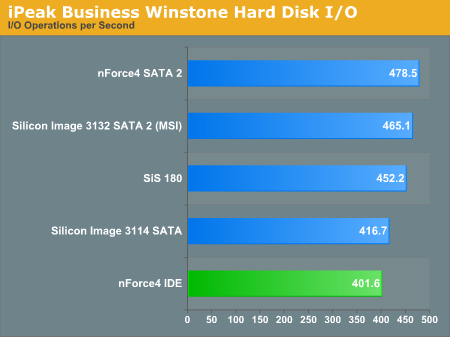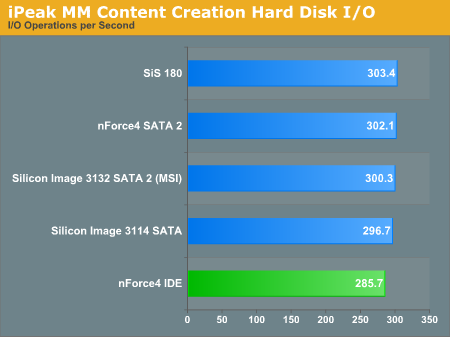nForce4 Ultra Roundup: Charting the Mainstream
by Wesley Fink on July 5, 2005 10:28 PM EST- Posted in
- Motherboards
Disk Controller Performance
With so many storage controllers on the nForce4 SLI boards, we needed a means of comparing performance of the wide variety of controllers. The logical choice was Anand's storage benchmark first described in Q2 2004 Desktop Hard Drive Comparison: WD Raptor vs the World. To refresh your memory, the iPeak test was designed to measure "pure" hard disk performance, and in this case, we kept the hard drive as consistent as possible while varying the hard drive controller. The idea is to measure the performance of a hard drive controller with a consistent hard drive. We played back Anand's raw files that recorded I/O operations when running a real world benchmark - the entire Winstone 2004 suite. Intel's IPEAK utility was then used to play back the trace of all the IO operations that took place during a single run of Business Winstone 2004 and MCC Winstone 2004. To try to isolate performance difference to the controllers that we were testing, we used Seagate 7200.7 model SATA and IDE hard drives for all tests.iPeak gives a mean service time in milliseconds; in other words, the average time that each drive took to fulfill each IO operation. In order to make the data more understandable, we report the scores as an average number of IO operations per second so that higher scores translate into better performance. This number is meaningless as far as hard disk performance is concerned as it is just the number of IO operations completed in a second. However, the scores are useful for comparing "pure" performance of the storage controllers in this case.


The Silicon Image 3114 controller is only a bit slower in MM Content IO, but it quite a bit slower in Business IO. The 3114 does uniquely feature RAID 3 capabilities.
IDE provided the slowest IO performance in this roundup, demonstrating that SATA controllers are finally starting to show a performance edge - at least in IO operations.
We also plan to include IDE RAID and SATA RAID benchmarks in future motherboard tests. Comparing RAID performance on various controllers will definitely be a part of future storage benchmarking and possibly motherboard tests as well as new on-board RAID controllers that are introduced.










75 Comments
View All Comments
Andreos - Thursday, July 7, 2005 - link
Wesley - That helps, thanks for educating me on this stuff.Wesley Fink - Thursday, July 7, 2005 - link
#51 - We reviewed the K8NXP-SLI in the SLI roundup and the Ultra counterpart is the K8NXP-9. If you will look closely at the Gigabyte website pictures of the K8N Ultra-9 you will see it is the same board with a passive heatsink and fewer features. For information on how your Gigabyte performs at stock speeds (which is all that interests you) then please refer to the single video benchmarks for the K8NXP-SLI in the SLI roundup. We report all benchmarks at stock speeds so you and other readers can compare performance. Overclocking is covered as a separate feature. If you do not choose to overclock that is your business, but the information you are asking for is fully covered in our reviews. ALL the nForce4 Ultra boards perform almost the same at stock speeds, which should not really come as a surprise since the memory controller is on the CPU. If you were expecting the Gigabyte K8N Ultra-9 would perform better at stock speeds that anything else then you are badly misinformed. The Gigabyte boards do very well at stock speeds, but all the nF4 boards are close in performance at stock speeds.#53 - The BFG VNF4 Ultra is a rebadged (relabeled) Chaintech VNF4 motherboard. We did review the Chaintech VNF4 Ultra in this roundup.
VinnyS - Thursday, July 7, 2005 - link
I would have liked to have seen the BFG NF4 Ultra board included in this round-up, it got high marks in a [H]ardOCP review. Any chance for an update to this review with this board included?TheGlassman - Thursday, July 7, 2005 - link
Well I was tired, You were using the 6-3-05 bios, should have quit while I was ahead. So now I have no idea what the problem was.At any rate the 6-3-05 bios is a dual core bios, so no flashing to a beta is needed for dual core.
Andreos - Thursday, July 7, 2005 - link
I don't think you guys know your audience all that well. Not everybody is into overclocking to the hairy edge. Some of us wnat a fast and quiet board with dead-nuts solid reliability. For that reason, it is incomprehensible that the Gigabyte GA-K8N Ultra-9 was not included in this so-called "roundup". This board has no SLI counterpart, but it is of extreme interest to a lot of folks planning workstations based on X2 processors (and for which overclocking is of lower interest than reliable operation). Wake up dudes - the game is changing! Clock speed is no longer the Holy Grail. Other sites are savvy to this and will soon be eating your lunch!Palek - Thursday, July 7, 2005 - link
#49, no worries. I don't work for Anandtech, by the way. :)By my "far more than a day" remark I intended to say that I figured a review like this would take more like a week at a minimum - quite possibly even longer - to put together, so by the time the article was released some BIOSes would be outdated, since BIOS updates seem to pop up every other day these days. That is all.
TheGlassman - Wednesday, July 6, 2005 - link
Sorry Palek, you didn't write the review, oops. My apologies to you and time for bed.Wesley, can you look into that?
Thanks, and I'm sure glad the over a day remark wasn't yours.
TheGlassman - Wednesday, July 6, 2005 - link
Thanks for your comments Palek, especially the latest and greatest comment. I checked the bios you used for the chaintech, it is a dual core only beta, ANY release bios including the 6-03-05 official dual core support (a month older than either of the winning (because they over clock TCCD better?) boards, and older than any dated bios) will perform much better in overclocking and probably every other test.If Chaintech shipped you a board with that bios it wasn't a wise move for a single core test. I think it would be fair to retest the chaintech vnf4 with a release bios, and if the results are different to note that.
As far as the time taken to prepare this round up, much less time could have been used running bench mark after benchmark that shows apprx the same performance, and I would expect it take more than a day to write up such a comprehensive review. To take a few days to do testing that can benefit people who will base their buying decisons on your results, I think would be worth while.
I am happy that I could pinpoint the problem with the Chaintech VnF4 Ultra results, as you may have guessed I am quite familliar with it. In the past, Anandtech has always explained why a beta bios was being used, I guess that it wasn't noted this time because you felt rushed.
PS I know the DFI's are excellent boards, but their site lists a march date for their most recent bios, so maybe you should have used that one instead of their latest and greatest TCCD overclocking beta bios, and since you were using a beta, you should, again, have listed why.
I'm sorry, saying it took more than a day is not good enough for the anandtech standards that have been so high for so long.
Wesley Fink - Wednesday, July 6, 2005 - link
We have corrected the CPU and Memory voltage adjustments for the Abit AN8 Fatal1ty. This version only has voltage adjustments to 2.8V for memory, while the later Ultra and SLI versions do support memory voltages to 3.55V.Palek - Wednesday, July 6, 2005 - link
Wesley, that would be "proofreading" - one word! ;) Is that a job offer? :)#41, TheGlassman, you shouldn't have unreasonable expectations. I'm sure this review took far more than a day to put together, so of course some of the BIOSes used will not be the latest and the greatest. Adding three different types of RAM to the mix would require even more time. Then if you want to test them with different divider etc. settings, suddenly you have over a hundred combinations, a benchmarking nightmare. You have to draw the line somewhere. This was not an article focused on overclocking, but a comparison of 7 motherboards. I would have liked to see the new Abit boards included as well, but I guess that review will come soon enough, too.